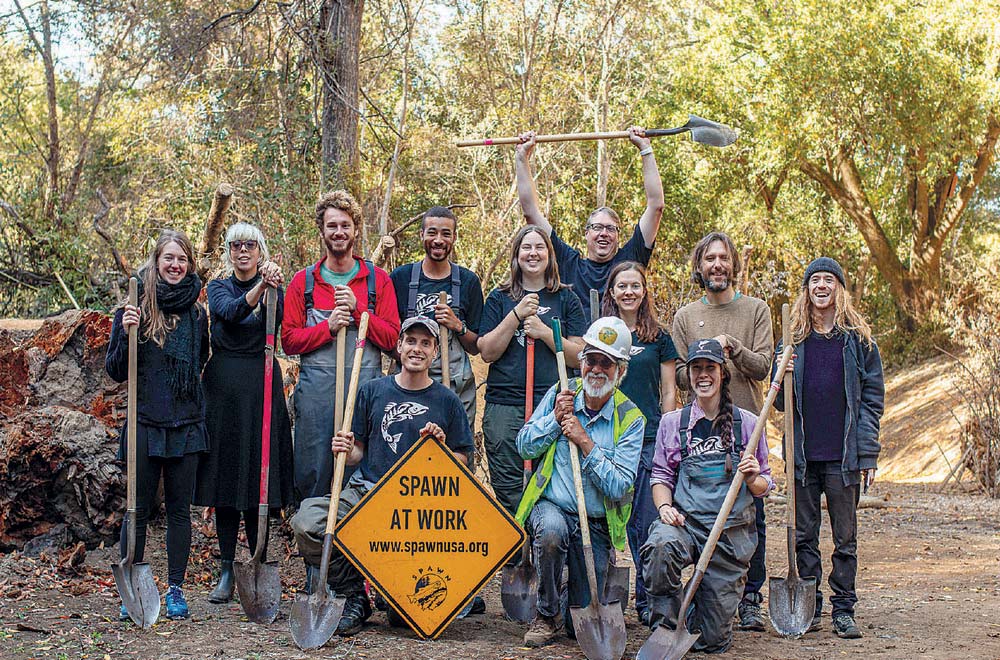Lagunitas Creek Floodplain & Riparian Restoration Project Transforms Second Marin Ghost Town into Coho Salmon Habitat

Salmon Protection And Watershed Network
This October, the Salmon Protection And Watershed Network, or SPAWN, completed the second phase of our floodplain and riparian restoration project at the ghost town of Jewell, in Northern California. Our work recreating floodplain wetlands along Lagunitas Creek will help recover key populations of endangered Central California Coast coho salmon. Conservation Partner Organizations at Work Page 36 Forest & River News a Winter 2019 The first step in restoring Jewell’s floodplain was to remove remnants of abandoned structures and haul out 6,000 cubic yards of fill to carve out new channels. The next step was to install large woody debris at strategic locations. By mid-September we were seeding native grasses and perennials along with installing erosion-control fabric. And finally, when the rains begin, SPAWN staff, interns, and volunteers will be joined by students at partner schools to plant several thousand native plants and plugs grown at SPAWN’s Native Plant Nursery.
Native plants provide multiple benefits to aquatic species. Water temperature is one of the most critical factors in salmonid incubation and development, and trees provide shade to keep temperatures cool in the summer. Vegetation also helps to stabilize banks and prevent fine sediment accumulation in the stream. This is another critical factor for coho because adult females need gravel beds to spawn (lay their eggs).
Many native plants such as willows attract insects—the dietary staple of juvenile coho—to the water. Vegetated corridors also improve water quality by filtering pollutants from stormwater before it flows into the nearest body of water. Other benefits of vegetated corridors are that they protect against flooding by slowing water velocity down, and they help recharge groundwater by infiltrating water back into the ground.
SPAWN began the first phase of the Lagunitas Creek Floodplain & Riparian Restoration Project in August 2018 in the Marin ghost town of Tacaloma. By digging and hauling out 13,000 cubic yards of dumped fill from the Tocaloma floodplain we were able to create new seasonal and perennial side channels. The channels held up well during the stormy winter months, and spring began with the sight of meadow barley spreading across the floodplain. It was rewarding to see scores of juvenile fish in the new channels by spring, as well as endangered California freshwater shrimp in our custom-designed shrimp structures.
In addition to growing plants that provide bank stabilization, SPAWN’s nursery also focuses on growing plants that provide direct benefits to all wildlife species that utilize the riparian corridor. Many of the plant species selected for both Tocaloma and Jewell provide benefits for multiple species of wildlife.
For example, creek dogwood has adventitious roots systems that provide food and cover for the endangered California freshwater shrimp; flowers that provide nectar for a variety of pollinators; and berries that are coveted by many bird species. Creek dogwood is also the host plant for the spring azure butterfly and many species of moths. Other plants added to the Tocaloma floodplain such as California aster, yarrow, and grassleaved goldenrod provide nectar to many species of butterflies, including the endangered western monarch.
The Lagunitas Creek Floodplain & Riparian Restoration Project has been made possible through funding and support by the California Department of Fish and Wildlife, State Water Resources Control Board, Environmental Protection Agency, State Coastal Conservancy, the National Park Service, and members of Turtle Island Restoration Network, which is the parent organization of SPAWN.
The project has also benefited from the support of hundreds of dedicated volunteers and students who have helped to both grow the plants in the nursery, and plant and maintain the plants at the restoration sites. More volunteer help will be needed starting this November to plant out the Jewell site. Planting events will be held on at least two Saturdays per month throughout the winter. If you are interested in volunteering, please contact SPAWN’s Native Plant Nursery Manager Audrey Fusco at [email protected].
For more info: https://seaturtles.org/ our-work/our-programs/salmon/
